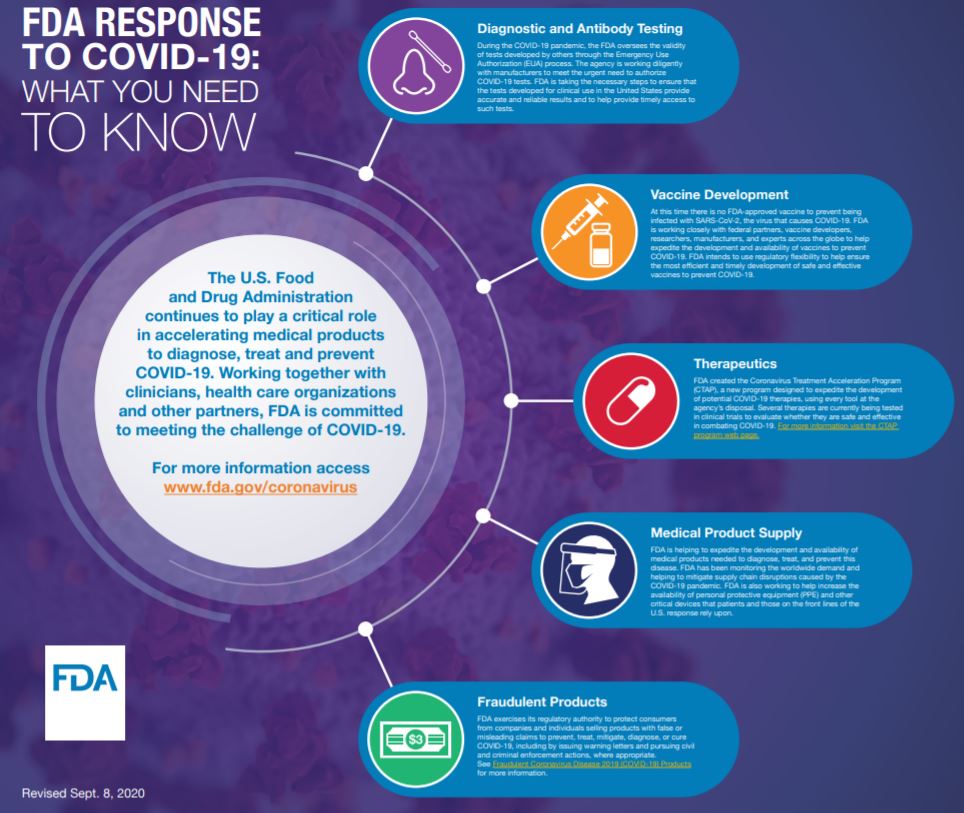COVID-19: CDRH response to date, Patient outreach toolkit, Laboratory safety, Vaccine EUA guidance, Medical countermeasures R&D
Center for Devices and Radiological Health’s (CDRH) Response to Coronavirus (COVID-19)
Timeline: January 1 – September 18, 2020
- Regulatory Flexibility: EUA templates, guidance documents, policies
- Emergency Use Authorizations: 10x medical devices the number authorized pre-2020, tests
- Shortage Mitigation Activities: Outreach to 1,000+ manufacturing sites across 12 countries
- Public Health Service Corps Deployment: 58 CDRH Commissioned Corps officers
- Engagement with Stakeholders: Emails, phine queries, webinars, townhalls
Patient Outreach Toolkit
Useful COVID-19 resources for healthcare professionals to share with patients
Fraudulent Products Factsheet
(English / Español – PDF, 1.2MB)
FDA Response to COVID-19: What You Need to Know Infographic
(English / Español – PDF, 4.4MB)
Approved COVID-19 Tweets
(English / Español – PDF, 1.6MB)
A Culture of Responsibility: Laboratory Safety at the FDA
In observance on NIH’s Biosafety & Biosecurity Month, FDA is implementing the folloiwng in its labs
- Proper use of PPE (masks, face shields, gloves, gowns, shoe covers)
- Engineering controls (biosafety cabinets, secure rooms)
- Administrative controls (risk assessment, pre-work approval, medical surveillance, respiratory protection programs)
- Best practices for decontaminating surfaces and proper procedures for packing and transporting any hazardous biomaterials, including SARS-CoV-2
Industry Guidance: Emergency Use Authorization for
Vaccines to Prevent COVID-19
Data and information needed for Emergency Use Authorization (EUA) for an investigational COVID-19 vaccine that could be potentially administered to millions of individuals
- Chemistry, manufacturing, and controls information (CMC); nonclinical data and information; and clinical data and information, as well as administrative and regulatory information
Safety and Effectiveness Information for evaluation of benefit-risk profile
- Bioassays for assessment of clinical endpoints
- Supportive nonclinical studies e.g., characterization of markers associated with enhanced disease, biodistribution, shedding, and attenuation)
- Clinical
a. Prespecified success criteria for primary efficacy endpoint (previous guidance), placebo controlled efficacy trial of at least 50%
b. All safety with focus on serious adverse events, adverse events of special interest, and cases of severe COVID-19 among study subject
c. Data from Phase 3 studies should include a median follow-up duration of at least two months after completion of the full vaccination regimen - In addition
a. Local and systemic solicited adverse reactions for reactogenicity
b. All safety data from database lack, n> 3,000
c. Sufficient cases of severe COVID-19 among study subjects
d. Sufficient cases of individuals with prior SARS-CoV-2 infection
Cellular signaling and immune correlates for SARS-CoV-2 infection
Research award to Stanford University to help inform the development and FDA review of COVID-19 medical countermeasures
- Explain host factors contributing to coronavirus immune responses to more rapidly predict patient outcomes
- Innovative in-depth analysis of existing tissue samples from previous clinical and nonclinical studies
- Profile circulating immune signatures of coronavirus infection, pathology, tissue imaging, tissue viral reservoirs, how different systems in the body are affected
Image credit: FDA, Stanford University




